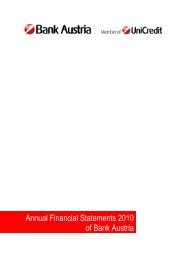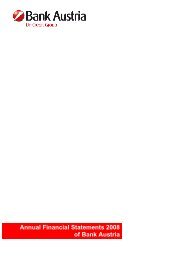Annual Financial Statements 2011 of Bank Austria
Annual Financial Statements 2011 of Bank Austria
Annual Financial Statements 2011 of Bank Austria
Create successful ePaper yourself
Turn your PDF publications into a flip-book with our unique Google optimized e-Paper software.
Management Report <strong>of</strong> UniCredit <strong>Bank</strong> <strong>Austria</strong> AG<br />
Market risk management in CEE<br />
At UniCredit <strong>Bank</strong> <strong>Austria</strong> AG, market risk management covers the<br />
activities in Vienna and the positions at the subsidiaries, especially<br />
in Central and Eastern Europe. These subsidiaries have local risk<br />
management units with a reporting line to Risk Management in<br />
UniCredit <strong>Bank</strong> <strong>Austria</strong> AG. Uniform processes, methods, rules and<br />
limit systems ensure consistent Group-wide risk management<br />
adjusted to local market conditions.<br />
The "IMOD" risk model has been implemented locally at major<br />
units (Czech Republic, Slovakia, Hungary, Croatia, Bulgaria,<br />
Russia, Turkey), and a daily risk report is made available to the<br />
other units. The replacement <strong>of</strong> the previous internal model<br />
“NoRISK” by IMOD, a Group application, also requires formal<br />
approval <strong>of</strong> the system by the banking supervisory authorities in<br />
the major CEE countries. The approval process for the Czech<br />
Republic, Slovakia and Hungary will be implemented by 2013; the<br />
other relevant banking subsidiaries will undergo the approval<br />
process for the risk model from 2014 onwards.<br />
Analyses <strong>of</strong> position structure and balance sheet structure are<br />
available to all banks in the Group via "ALMRisk", a Group-wide<br />
web tool. Liquidity monitoring is also based on this instrument. The<br />
instrument was extended in the course <strong>of</strong> <strong>2011</strong> to cover liquidity<br />
requirements under Basel 3.<br />
The web application "ERCONIS" records the daily business results<br />
<strong>of</strong> treasury activities in CEE. In line with a total-return approach,<br />
measurements <strong>of</strong> the performance <strong>of</strong> subsidiaries include income<br />
generated by the subsidiaries and the valuation results <strong>of</strong> the<br />
banking book.<br />
To avoid risk concentrations in the market risk position, especially<br />
in tight market conditions, the bank has implemented at its<br />
subsidiaries Value-at-Risk limits and position limits for exchange<br />
rate risk, interest rate risk and equity risk, which are monitored<br />
daily. The additional capital requirements for trading books<br />
(“incremental risk charge” and “stressed VaR”) which became<br />
effective in <strong>2011</strong> are monitored using separate indicators. The<br />
monitoring <strong>of</strong> income trends at banking subsidiaries by means <strong>of</strong><br />
loss-warning levels provides an early indication <strong>of</strong> any<br />
accumulation <strong>of</strong> position losses. The timely and continuous<br />
analysis <strong>of</strong> market risk and income is the basis for integrated riskreturn<br />
management <strong>of</strong> treasury units at banking subsidiaries.<br />
Liquidity risk<br />
General information, processes and management model<br />
In line with Group standards, the <strong>Bank</strong> <strong>Austria</strong> Group deals with<br />
liquidity risk as a central risk in banking business by introducing<br />
and monitoring short-term and medium-term liquidity requirements.<br />
In this context the liquidity situation for the next few days and<br />
months and also for longer periods is analysed against a standard<br />
scenario and stress scenarios. Methods and procedures <strong>of</strong> liquidity<br />
analysis, analyses <strong>of</strong> the degree <strong>of</strong> liquidity <strong>of</strong> customer positions,<br />
management responsibilities and reporting lines in this area have<br />
been laid down in the liquidity policy, which is also applicable at<br />
<strong>Bank</strong> <strong>Austria</strong>’s CEE units and includes a contingency plan in the<br />
event <strong>of</strong> a liquidity crisis.<br />
Liquidity management in UniCredit <strong>Bank</strong> <strong>Austria</strong> AG is an integral<br />
part <strong>of</strong> UniCredit Group liquidity management. In line with the<br />
Group-wide distribution <strong>of</strong> tasks, <strong>Bank</strong> <strong>Austria</strong> ensures the<br />
consolidation <strong>of</strong> liquidity flows and the funding for subsidiaries in<br />
<strong>Austria</strong> and CEE. The flow <strong>of</strong> funds is thereby optimised and<br />
external funding is reduced to the necessary extent. Liquidity<br />
transfers within the Group are based on market prices.<br />
Liquidity management methods and control<br />
In medium-term and long-term liquidity management, liquidity<br />
inflows over 1 year and over 5 years must cover a minimum <strong>of</strong> 90<br />
% <strong>of</strong> expected liquidity outflows during these periods. This limit<br />
must be observed at Group level and for each banking subsidiary.<br />
The limit is to be observed also at individual currency level in order<br />
to avoid cross-currency funding arrangements as far as possible.<br />
At <strong>Bank</strong> <strong>Austria</strong> Group level, the liquidity ratio as at year-end <strong>2011</strong><br />
was 0.99 for > 1 year and 0.98 for > 5 years. This means that in<br />
effect, long-term assets are fully funded at Group level.<br />
For the purpose <strong>of</strong> short-term liquidity management, volume limits<br />
have been implemented in the <strong>Bank</strong> <strong>Austria</strong> Group and in all banks<br />
for maturities up to three months, which limit all Treasury<br />
transactions and the securities portfolio <strong>of</strong> the respective bank.<br />
Volume limits are also established for open maturities in various<br />
currencies to keep down the risk <strong>of</strong> a need for follow-up funding in<br />
the event that foreign currency markets dry up.<br />
These limits were essentially observed although the liquidity<br />
situation in financial markets deteriorated significantly in the<br />
second half <strong>of</strong> the year, not least on account <strong>of</strong> the persistent<br />
government debt crisis in Europe.<br />
Liquidity stress test<br />
UniCredit <strong>Bank</strong> <strong>Austria</strong> AG performs liquidity stress tests for the<br />
Group and for individual banks on a regular basis, using a<br />
standardised Group-wide instrument and standardised Group-wide<br />
scenarios. These scenarios describe the effects <strong>of</strong> market-driven or<br />
name-driven crisis signals on liquidity inflows and outflows, with<br />
assumptions also being made about the behaviour <strong>of</strong> non-banks.<br />
The liquidity outflows expected to occur in stress situations are<br />
compared with available collateral (essentially, securities and credit<br />
instruments eligible as collateral at the central bank) to examine<br />
the banks’ risk-taking capability in the short term up to two months.<br />
The tight liquidity situation in financial markets (especially in the<br />
interbank market) put a strain on these crisis scenarios, but the<br />
existing pool <strong>of</strong> collateral was sufficient to cover liquidity outflows.<br />
The extreme scenario (combining an extreme market crisis and a<br />
name-driven crisis) calculated on the basis <strong>of</strong> the strained liquidity<br />
situation is below the one-month liquidity horizon. However,<br />
measures have been taken to strengthen the liquidity buffer for<br />
unexpected liquidity outflows.<br />
<strong>Bank</strong> <strong>Austria</strong> – <strong>Annual</strong> <strong>Financial</strong> <strong>Statements</strong> <strong>2011</strong> 198
















